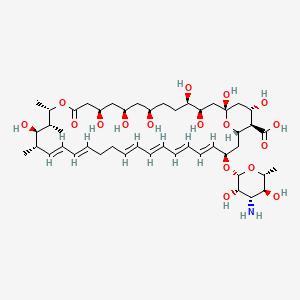| MeSH term | MeSH ID | Detail |
|---|---|---|
| Hemolysis | D006461 | 131 associated lipids |
| Diarrhea | D003967 | 32 associated lipids |
| Otitis Media | D010033 | 12 associated lipids |
| Adenocarcinoma | D000230 | 166 associated lipids |
| Dermatitis, Contact | D003877 | 59 associated lipids |
| Dermatitis, Occupational | D009783 | 12 associated lipids |
| Bacterial Infections | D001424 | 21 associated lipids |
| Otitis Externa | D010032 | 8 associated lipids |
| Stomach Diseases | D013272 | 7 associated lipids |
| Genital Diseases, Female | D005831 | 7 associated lipids |
nystatin
nystatin is a lipid of Polyketides (PK) class. Nystatin is associated with abnormalities such as Virus Diseases, Infection, Candidiasis, Leukopenia and Mycoses. The involved functions are known as Membrane Potentials, Uptake, Flow or discharge, Cell membrane potential and adenine transport. Nystatin often locates in Cell Wall, Plasma membrane, Extracellular, Membrane and Virion. The associated genes with nystatin are Genome, Integral Membrane Proteins, Amino Acids, Basic, P4HTM gene and Homologous Gene. The related lipids are Sterols, Liposomes, Membrane Lipids, Sphingolipids and 1,2-oleoylphosphatidylcholine. The related experimental models are Knock-out and Xenograft Model.
Cross Reference
Introduction
To understand associated biological information of nystatin, we collected biological information of abnormalities, associated pathways, cellular/molecular locations, biological functions, related genes/proteins, lipids and common seen animal/experimental models with organized paragraphs from literatures.
What diseases are associated with nystatin?
nystatin is suspected in Infection, Mycoses, Candidiasis, Renal tubular disorder, Systemic mycosis, Invagination and other diseases in descending order of the highest number of associated sentences.
Related references are mostly published in these journals:
| Disease | Cross reference | Weighted score | Related literature |
|---|
Possible diseases from mapped MeSH terms on references
We collected disease MeSH terms mapped to the references associated with nystatin
PubChem Associated disorders and diseases
What pathways are associated with nystatin
There are no associated biomedical information in the current reference collection.
PubChem Biomolecular Interactions and Pathways
Link to PubChem Biomolecular Interactions and PathwaysWhat cellular locations are associated with nystatin?
Visualization in cellular structure
Associated locations are in red color. Not associated locations are in black.
Related references are published most in these journals:
| Location | Cross reference | Weighted score | Related literatures |
|---|
What functions are associated with nystatin?
Related references are published most in these journals:
| Function | Cross reference | Weighted score | Related literatures |
|---|
What lipids are associated with nystatin?
Related references are published most in these journals:
| Lipid concept | Cross reference | Weighted score | Related literatures |
|---|
What genes are associated with nystatin?
Related references are published most in these journals:
| Gene | Cross reference | Weighted score | Related literatures |
|---|
What common seen animal models are associated with nystatin?
Knock-out
Knock-out are used in the study 'Parallel genetic changes and nonparallel gene-environment interactions characterize the evolution of drug resistance in yeast.' (Gerstein AC et al., 2012).
Xenograft Model
Xenograft Model are used in the study 'Cholesterol sequestration by nystatin enhances the uptake and activity of endostatin in endothelium via regulating distinct endocytic pathways.' (Chen Y et al., 2011).
Related references are published most in these journals:
| Model | Cross reference | Weighted score | Related literatures |
|---|
NCBI Entrez Crosslinks
All references with nystatin
Download all related citations| Authors | Title | Published | Journal | PubMed Link |
|---|---|---|---|---|
| Wu SC et al. | Hyaluronan size alters chondrogenesis of adipose-derived stem cells via the CD44/ERK/SOX-9 pathway. | 2018 | Acta Biomater | pmid:29128538 |
| Bouallegui Y et al. | Effect of exposure time, particle size and uptake pathways in immune cell lysosomal cytotoxicity of mussels exposed to silver nanoparticles. | 2018 | Drug Chem Toxicol | pmid:28583008 |
| Honsho M et al. | Plasmalogen biosynthesis is spatiotemporally regulated by sensing plasmalogens in the inner leaflet of plasma membranes. | 2017 | Sci Rep | pmid:28272479 |
| Gadd GM | New horizons in geomycology. | 2017 | Environ Microbiol Rep | pmid:27701824 |
| Rajendran K et al. | Brain-Eating Amoebae: Silver Nanoparticle Conjugation Enhanced Efficacy of Anti-Amoebic Drugs against Naegleria fowleri. | 2017 | ACS Chem Neurosci | pmid:29206032 |
| Dos Santos AG et al. | The molecular mechanism of Nystatin action is dependent on the membrane biophysical properties and lipid composition. | 2017 | Phys Chem Chem Phys | pmid:29098221 |
| Tang H et al. | Effect of inhibitors of endocytosis and NF-kB signal pathway on folate-conjugated nanoparticle endocytosis by rat Kupffer cells. | 2017 | Int J Nanomedicine | pmid:29075112 |
| Won HJ et al. | Improved recovery and biological activities of an engineered polyene NPP analogue in Pseudonocardia autotrophica. | 2017 | J. Ind. Microbiol. Biotechnol. | pmid:28555391 |
| Zhang D et al. | Residual detection of buparvaquone, nystatin, and etomidate in animal-derived food products in a single chromatographic run using liquid chromatography-tandem mass spectrometry. | 2017 | Food Chem | pmid:28763970 |
| Kunz D et al. | Receptor mediated endocytosis of vicilin in Callosobruchus maculatus (Coleoptera: Chrysomelidae) larval midgut epithelial cells. | 2017 | Comp. Biochem. Physiol. B, Biochem. Mol. Biol. | pmid:28630013 |
